The Mahler
Symphonies
A synoptic survey by Tony Duggan
Review of BOXED SETS of MAHLER Symphonies by
Tony Duggan
When I'm asked for the best way to build a collection of Mahler's symphonies
I always say compile it from single releases by different conductors rather
than buy a boxed set conducted by one. The reason lies buried in the phrase
by Neville Cardus that with each symphony Mahler "sheds a skin". Each work
is different from the one preceding it, each needs a subtly different approach
from conductor and orchestra, and, after more than thirty years of listening
to Mahler, I'm convinced no one conductor is truly capable of responding
equally well to all the symphonies - though a couple come close. This means
that when you buy a box containing one conductor's cycle you usually end
up with a number of the works in performances that fall short of the best
available. I am, of course, aware that one person's definition of "best"
will differ from another's but as a general rule I've found one-conductor
cycles don't satisfy over the whole canon. The raison d'être
for my survey of Mahler recordings has been to help navigation through the
individual releases and to build that cycle.
In the past some conductors recognised all this. Bruno Walter and Otto Klemperer
never touched certain symphonies. Both admitted to not understanding the
Sixth, for example. Klemperer himself only regularly performed a handful
of Mahler's works yet based a reputation as a Mahlerian on that alone. Would
that today's conductors had that humility. Today no conductor's career seems
valid without his complete Mahler cycle to go with his complete Beethoven
cycle. Indeed I have the impression that Mahler has taken over from Beethoven
in the conductor's "wish list" when he signs the recording contract. Mahler
is expensive to record but Mahler sells and so conductors continue
to get their way. The winner in all this is certainly the collector. The
downside is that there are more and more recordings of Mahler that will not
last. There is also the nightmare scenario of conductors who should never
be allowed within a mile of a Mahler score but who nevertheless get to play
with their "train sets" in front of the public.
I do not, as some of my less charitable correspondents think, only favour
recordings by conductors who are either very old or very dead. Anyone who
has taken the trouble to read the whole of my survey of Mahler recordings
will see I place some recent versions, some of them by young men, high on
my lists. Thomas Sanderling, Gatti, Shipway, Tilson Thomas, Levi, Welser-Most,
Lopez-Cobos and Rattle receive glowing mentions from me for some of their
recordings. So I think that answers that canard conclusively. It's just that
I believe for any recording to succeed it does have a lot of great acts to
follow.
Great Mahler performances and recordings hit you full in the face. They insist
themselves into any list of recommendations. But I have to say I do not believe
it to be the case, as other correspondents have also insisted to me, that
new necessarily means better. Quite the opposite can be true. I do
accept that orchestras can play the notes with more efficiency now than they
did twenty or forty years ago and certainly no composer can expose the second
rate quite like Mahler. There are also advances in recording technology to
take into account as Mahler benefits from the very best sound engineering.
But I do feel that some recent recorded performances have lost something
of the harder edge to Mahler's music earlier interpreters brought to it through
their sense of discovery or of being closer the world of ideas Mahler came
from. Certainly there has been an underlying tendency to make tempi slower,
for example. As if by so doing the conductor can wring more emotion out of
Mahler because they think that is what the public wants and therefore needs.
This imbalance is to be discouraged. Poor, tragic, doomed, victimised
Mahler seems to be the message in those instances. I say remember Mahler
as a man of ideas, a man of action, a man who loved life and celebrated it
in all its beauty and all its ugliness - and balance the whole man.
These works are a lot more than orchestral showpieces, a lot more than "machines
for pleasing" and a lot more than exercises in tear jerking and elation pumping.
They are often uncomfortable "awkward squads" and the interpreter who misses
that element is cheating the public badly. Great precision in playing is
to be welcomed, and great recorded sound too, but neither should be at the
expense of missing the real Mahler. If I have to sacrifice perfection of
execution and recorded sound I will do so gladly, and so should you.
To be fair there are other considerations to take into account in the question
of boxed sets which is why I've added this Appendix to my survey. For example,
there's no question that it's easier to walk into a shop, or go to an online
site, and come away with one purchase rather than twelve. You can also get
good deals with regards to price when you "bulk buy" your Mahler. It's also
interesting to have one person's view, one orchestra's performances, one
producer and engineer's sound stage, to get an "overview. So I will give
you a few ideas as to what I think are one-conductor cycles worth seeking
out for all their drawbacks and those that I think are better avoided. As
usual this is a very personal selection. There will be the usual disappointments.
Supporters of this conductor or that conductor will, no doubt, ask why I
have left out their favourites but if you have been following my survey you
will be well used to my preferences. But first there is another class of
boxed sets altogether. Those that are not one-conductor cycles (at least
not in the conventional sense) but which contain performances gathered together
for other reasons. I'll call these "special event" boxes and there are a
four of them I want to draw to your attention as additions to your collections.
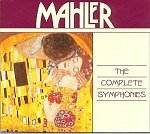
The first of these is "The Complete Symphonies", an eleven-disc bargain
set on
Brilliant
Classics (99549) £29.99 of all Mahler's completed
symphonies taken from different sources. I include it because at such a low
price it would make a perfect addition to the collection of someone starting
out in Mahler or wanting to experiment. The First Symphony gets a performance
of contrasts and maximum involvement by the Royal Philharmonic under Yuri
Simonov. The Second, by the Residentie Orchestra of The Hague under Hans
Vonk, is the weakest link. The first movement is unimaginative and the sound
recording lacking in impact. There is more charm in the second movement but
this hardly compensates as the third shows the same shortcomings as the first.
The last movement saves the performance from descending into boredom as Vonk
keeps things moving, but again there's much more that can be made of this.
Next I count the version of the Third conducted by Jascha Horenstein one
of the greatest of all Mahler recordings and you can read a detailed review
of this in my survey on the Third Symphony. Hartmut Haenchen's Fourth benefits
from a big acoustic that allows lower woodwind to tell in a warm but very
fluent performance. In the Fifth Vaclav Neumann's view of the first movement
is stiff and unyielding, adding some excitement to the frantic central section
though not enough contrast to stop me feeling cheated. Neumann's failure
to bury himself in the second movement also means we hear mostly sound and
fury only. Things improve in the Scherzo and the clear-headed Adagietto,
but the last movement doesn't contrast enough with the first. On to Hartmut
Haenchen's Sixth recorded "live", which probably accounts for some lapses.
The first movement is under-powered with Haenchen unable to decide the mood.
In the last movement the problems of "live" performance and Haenchen's inability
to penetrate the terrible message confirms this as an average performance
only. Kurt Masur conducts the Seventh in Leipzic and provides a clear nightscape
in Mahler's "night into day" journey. In the first movement he is also good
on the inner tempo relationships and brings clarity to the canvas. Neeme
Jarvi conducts the Eighth "live" in Gothenburg. This has a fleet, athletic
account of Part I rather lacking in critical mass". In Part II the Prelude
is notable for clarity so some sacrifice of atmosphere is inevitable. This
is a Part II for the brightest part of the day. Finally, the first movement
of the Ninth under Neumann is a good Andante comodo that allows a course
between nostalgic repose and penetrating drama. The sound balance also means
we hear how good the Gwandhaus Orchestra is. Neumann knows how to deliver
nodal climaxes, never losing sight of the big picture. To sum up, smart friends
with money to burn might cast aspersions on this bargain basement set but
if this is all that can be afforded it will last you quite well.
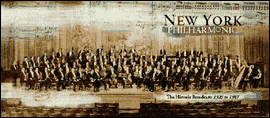
At the other end of the price range is the kind of set smart friends
will have displayed prominently on their shelves but which I want
to draw to your attention nevertheless. "The Mahler Broadcasts
1948-1982" is a lavish twelve-disc collection containing "live" New York
Philharmonic performances - effectively an NYPO Mahler cycle.
order
It comes with a sumptuous 500-page book with essays, interviews, notes and
reviews, photos from the archives, documentation of Mahler's time with the
orchestra and a list of the orchestra's Mahler performances. Completing the
set is the famous radio documentary "I Remember Mahler" containing recollections
by musicians who played in the NYPO under Mahler. The elderly Alma Maher
herself was in the audience in 1959 for Sir John Barbirolli's ripe reading
of the First Symphony. The performance itself moves from the sunshine meadow
of the first movement to ethnic revelry in the second and a splendid Mahler
funeral march in the third showing Sir John in tune with the mix of irony
and beauty. The fourth movement is an excellent, triumphant crown with fine
brass playing bringing this distinctive performance to a fine conclusion.
The Second Symphony comes from the NYPO's 10,000th concert in 1982. Zubin
Mehta was Musical Director and rises to the occasion with a performance superior
to his Decca version with the Vienna Philharmonic. The marvellous Maureen
Forrester adds lustre to the performance too. The NYPO's next Director was
Pierre Boulez who conducts the Third Symphony. This will strike some as more
romantic, more suffused with warmth, than they expect. But this is always
the case with Boulez who seems doomed to be judged by people's preconceptions.
There is fabulous brass playing in the first movement and Yvonne Minton is
inspired in the fourth. Georg Solti then conducts the Fourth Symphony from
1962 and shows a different Mahlerian to the one heard in his Chicago cycle
for Decca. He is relaxed and genial here, not at all the ruthless drillmaster.
Klaus Tennstedt next delivers his characteristically involved and vital reading
of the Fifth that can also be heard in his "live" London Philharmonic recording
for EMI. The NYPO brass are superb and the strings appropriately lyrical
with the Adagietto especially passionate. Tennstedt has his fanatical admirers
and they will love this roller-coaster ride that demands to be heard at least
once. Next a truly great performance of the Sixth under Dimitri Mitropoulos
at Carnegie Hall in 1955. In my complete survey of Sixth Symphony recordings
I deal with this in detail and recommend you to read that to see how highly
I rate it. The playing more than justifies the NYPO's reputation as one of
the great Mahler ensembles and proves beyond doubt they could play Mahler
magnificently before Bernstein came along and usurped his mentor. The difficult
Seventh Symphony gets a fascinating performance from Rafael Kubelik who is
a surprise guest in this box. His performance is almost one third as long
as his DG studio recording dealt with below. The outer movements are especially
deep and profound and I confess to not being able to make up my mind about
this performance. A brave and inspired choice for this box, though. Next
comes Leopold Stokowski who was present at the first performance of the Eighth
Symphony in Munich in 1910 and also gave the first American performance of
it in 1916. His 1950 reading at Carnegie Hall is the stuff of legend and
here at last is a transfer of the broadcast tape that does this great occasion
proud. Forget any ideas about Stokowski the "liberty taker". The old wizard
gives a scrupulous reading, inspired from first to last, with little allowance
needing to be made for the age of the sound. This set also includes "Das
Lied Von Der Erde" and the recording is the oldest here with Bruno Walter
directing Kathleen Ferrier's American debut in 1948. We find her in even
better form here than she was for Walter in her Vienna recording for Decca
four years later. Set Svanholm is also inspired in the tenor songs and this
transfer is far superior to the one you may have heard from acetates available
on a Naxos release. Sir John Barbirolli then has the distinction of being
the only conductor in the set to appear twice in complete symphonies. His
Ninth from 1962 is characteristically eloquent though it doesn't quite match
the level of inspiration reached in his Berlin Philharmonic recording for
EMI a year later. The 1962 broadcast sound is not as good as some others
in this set being a little thin-toned. Nevertheless, this is still a performance
to be treasured. Bringing up the rear are excellent performances from 1960
and 1958 of the Adagio and Purgatorio from the Tenth conducted by Mitropoulos
who seems to get under the skin of this music as it stands like few others.
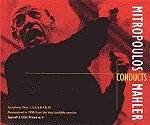
Which brings us conveniently to the next "special event" box I want to deal
with which is "Mitropoulos Conducts Mahler". This is a
set collecting some "live" performances by a conductor of the previous generation
who is often overlooked. A pity because Dimitri Mitropoulos's view of Mahler
comes before what can best be described as that hint of "smoothing out" that
has crept into Mahler performances as orchestras and conductors became more
familiar with the works and which has not been to Mahler's advantage. In
1960 the NYPO mounted a festival to commemorate Mahler's centenary and
Mitropoulos conducted the First, Fifth and Ninth symphonies, plus the Adagio
from the Tenth. These make the majority in this six-disc set on Music and
Arts (CD-1021 with ordering and samples at:
Mitropoulos Conducts Mahler
CD-1021). The first movement of the First Symphony strikes a balance
between a romantic, dark-hued world of the Wayfarer theme and sharp birdcalls.
The second movement is wilful and could irritate but the coarse-grained double
bass solo at the start of the third movement shows Mitropoulos never prettifies
Mahler. He then tears into the finale with abandon and encourages his players
to go for broke. Next is the Fifth Symphony where Mitropoulos has the measure
of the mood swings in the first and second movements. Problems start with
the Scherzo, though. The way Mitropoulos tears into it says a lot about how
I think he misses the point and with it that of the whole work, because the
symphony pivots on the way this movement provides a "junction box" for the
war between positive and negative. The reprise of the Adagietto in the last
movement is interesting in that Mitropoulos takes it slowly and makes the
connection between the two movements better than many. Finally in the Ninth
Symphony the first movement is forward-looking and edgy, which is a surprise
after the Fifth for the restraint and clarity Mitropoulos brings. The second
movement then receives a quick performance with the Tempo I Landler especially
testing the orchestra and the Tempo II Waltz wild and turbulent. In the Rondo
Burleske the basic tempo is steady enough for each note to tell and this
is followed by a searing performance of the last movement. At twenty-one
minutes it is one of the quickest on record but since all Mitropoulos's tempi
overall are quicker you shouldn't really notice. Following these 1960 recordings
the Third is with the NYPO in 1955. There are cuts in this and some fast
tempi injecting impatience, so on its own this would be a recording to give
a wide berth to. There is, of course, a better Sixth by Mitropoulos in the
"Mahler Broadcasts" box dealt with above but I still believe this Cologne
Radio version from 1960 deserves consideration. Mitropoulos was more
interventionist in this performance, especially in his deliberate treatment
of the fate rhythm in the first movement. There are awkward gear changes
too but, as so often, Mitropoulos can bring out the sharp, uncomfortable
sound of Mahler very tellingly. The Eighth from the 1960 Salzburg Festival
is the most distinguished performance here. Mitropoulos's tempo in Part I
stresses grandeur and solidity but then, as the central double fugue progresses,
a sense of momentum builds up. In Part II Mitropoulos's ability to bend with
the music delivers a moving experience, contrasting the first part admirably.
Then, as the soloists appear, their fine qualities are confirmed in every
case. To sum up, this is an essential box for admirers of both Mahler and
Mitropoulos. A window into Mahler performing styles prior to the boom of
the 1960s.
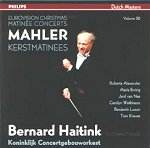
Finally in these "special event" boxes is what might seem a one-conductor
cycle but which isn't quite. "Mahler Kerstmatinees" is a nine-disc
box from Philips (Dutch Masters 50) only available
from Holland. order
by e-mail. For a number
of years on Christmas Day in the 70s and 80s Bernard Haitink and the
Concertgebouw Orchestra would perform a Mahler symphony in Amsterdam with
the concert televised "live" to most of Europe. I'm pleased to say the stereo
broadcast tapes have now been gathered in this box. The Sixth and Eighth
Symphonies are absent as these were never performed in the series so what
we have are 1,2,3,4,5,7,9 and some songs. However you can always supplement
a Sixth from Haitink's studio recordings. (Haitink's studio recording of
the Eighth is bland and dull in the extreme.) The booklet interestingly mentions
the difference in Haitink "live" and Haitink in the studio, which is something
I have always noticed. So often his "live" performances have more life, intensity
and sense of involvement than his studio recordings so this set is important
since few conductors know these score better and no orchestra plays them
better. Here you will hear conductor and players taking risks and seeming
to respond to the sense of occasion these concerts brought with them. The
Third, Seventh and Ninth Symphonies are especially fine and the Concertgebouw
Orchestra is on top form throughout. Netherlands Radio was responsible for
the sound and they have done this wonderful orchestra proud with better sound
to that you will hear in Haitink's first and complete studio cycle on Philips
(4420502). From the deepest bass to the highest treble
everything is heard in superb balance. Highly recommended.
So now to single conductor cycles and two that can be recommended almost
without reservation as they are by conductors whose views of Mahler, whilst
being personal and distinctive, reach a level of achievement that is consistent
over the whole canon to give that "overview" I mentioned earlier as valuable.
They are by Rafael Kubelik on DG and Leonard Bernstein on Sony. If you want
only one interpreter's views on the whole cycle these should be at the top
of your list for consideration.
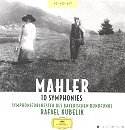
[Crotchet
£59.95
Amazon
UK
£60.99] Rafael Kubelik's
cycle on DG (463 738-2) has truths in it corrective to many more "demonstrative"
versions. He is especially good in Mahler's "Wunderhorn" moods but can surprise
in later works where a more Modernist approach is called for. In the First
Symphony he recognises a young man's work tied to nature and rejected love.
Notice the purity of the opening, the piquancy of the birdcalls, the unfussy
phrasing of the main theme. In the third movement he is aware of the grotesques
but never distorts or smooths out. Then he crowns the recording with a dramatic
last movement though not at the expense of ardour. In the Second Symphony
the first movement has weight with electric tempi and the big ascending theme
strong on "Wunderhorn" character. Kubelik is almost as fine as Klemperer
is in bringing out stranger sounds too. The start of the fifth movement has
all the drama you could want and the "voice in the wilderness" is imposing
with delicate horns over harps and woodwinds and fluttering violins with
growls from basses and contrabassoons with bass drum. Admire too the sense
of architecture and the piercing Bavarian brass. Kubelik's Third Symphony
is a classic with unity and purpose that pays as much attention to inner
movements as outer with playing of poetry and charm. In the first
movement Kubelik echoes Schoenberg's belief of a struggle between good and
evil and listen to the savage basses and cellos and raw trombone solos. In
the last movement no one offers a more convincing tempo either. Next in the
Fourth Symphony Kubelik recognises a chamber-like work. Tempi are quicker
but never at the expense of detail. Again there is a nice line in grotesques.
Then in the slow movement I hear the same singing line as Bruno Walter. Also
woodwind against strings are reproduced beautifully. The Fifth Symphony then
gets a lean performance from Kubelik. No "fat on the bone" in the first movement
and a bit lacking in tragedy. The second movement is fierce, the abrasive
recorded sound a trial, but the pacing is faultless. In the Scherzo there
is spring in the step, joy and carnival, though the sound is still a problem.
This is the weakest performance in the cycle but still worth hearing. The
Sixth Symphony is riveting, however. Though the first movement is fast it
stresses the classical nature of this classically structured movement
and it also makes us see Mahler's "hero" prior to the Tragedy that overwhelms
him. The compelling Scherzo reinforces the rigour of the first movement:
consistent and uncompromising it reminds us Kubelik was an exponent of
20th century music. The third movement is unselfconscious, but
notice the nostalgic trumpet. Then in the last movement Kubelik suggests
menace and tension in the opening and the rest balances the first movement
in being sharp with Tragedy integrated into the structure. After this the
Seventh Symphony gets a performance consistent with Kubelik's general approach.
The first movement is fluent with symphonic structure paramount; alive to
the new sounds Mahler experiments with, accentuated by a close balance. In
the second movement Kubelik remembers this is a march and doesn't smooth
out. The malevolent Scherzo finds every nerve exposed and after a tense second
Nachtmusik the last movement goes off like a rocket with those prominent
"baroque" trumpets. On to the Eighth and Kubelik's recording suffers first
from restrictions of sound. There is an element of grandeur missing in Part
1 with Kubelik direct to the point of correctness as well. Part 2 fares better.
The Prelude is impetuous and notice passages where Kubelik brings out the
"Chinoisserie" Mahler will rely on in "Das Lied Von Der Erde". This recording
has a fine solo team too. The first movement of the Ninth Symphony gets a
dynamic reading with the building bricks of the movement clinically presented.
A tough reading aware of the jagged contours of Mahler's late sound world
with lines clear. The second movement is full of character and the Rondo
Burleske contains tension though there are more "unhinged" versions out there.
Less than twenty-two minutes might seem short for the fourth movement but
what matters is overall pacing fitting with those of the other movements.
Finally in the Adagio from the Tenth Kubelik is the one of the few who makes
it seem like a complete work in itself. To sum up, listen to this cycle "in
one" and its virtues become apparent. You will gather I regard it as nearly
indispensable.

[Crotchet £114.94
Amazon
UK £108.99
Amazon
US $164.67] There are two recorded Mahler cycles from
Leonard Bernstein. The first is with the New York Philharmonic (and
the LSO for the Eighth Symphony) for Columbia made in the 1960s and
the second for DG made in New York, Vienna and Amsterdam in the 1980s.
Along with Kubelik Bernstein is one of the two conductors on record
who for me reaches a level of consistency over the whole cycle that
is deeply impressive, even though there are aspects I have disagreements
with. In contrast to Kubelik Bernstein is more emotionally engaged and
there is frequently a "life or death" struggle going on that can be
compelling when appropriate if irritating when not. It's a set of attitudes
Bernstein delivers every time without fail and for that his cycle must
go into this particular survey as a leading recommendation because here
is another set to give you a specific and consistent "overview" from
one interpreter's viewpoint. Of the two Bernstein cycles I prefer the
earlier one that now resides with Sony, but the one on DG (459080) is
almost on the same level of achievement. How very alike his individual
interpretations are after twenty years is more proof of Bernstein's
consistency but I find the younger Bernstein's energy, sense of wonder
and discovery even more compelling. The versions by him of the Third
and Seventh Symphonies remain among the greatest Mahler recordings ever
set down and I reviewed them in some detail in my surveys of those works
to which I direct you. At the point of writing this earlier cycle is
not in the catalogue but I'm assured Sony will be reissuing it early
in 2001 at bargain price.
2009 update - see
reissue of remastered Sony set

[Crotchet
£59.95
Amazon
UK £56.99] Bernard Haitink's studio cycle on Philips (4420502)
is another one-conductor set which, as a set, I rate almost on a par with
Kubelik's and Bernstein's for the Amsterdam Concertgebouw Orchestra's
authoritative playing and Haitink's integrity. These are central, solid
interpretations of depth and stature if a little lacking in character. You
could say they are a "third way" between Kubelik and Bernstein. Apart from
the Ninth and Seventh there isn't one individual symphony in this set I would
recommend on its own but, as a set, it does have a lot going for it, even
though Haitink himself is heard to much greater advantage in the "live" Christmas
Matinee set already mentioned.
There are many other boxed sets containing complete cycles by one conductor
and orchestra. You will often see some good bargains among them too. But
I remain convinced that none of them can compare with either building your
own cycle from individual recordings or relying on Kubelik, Bernstein or
even Haitink to give that overview I mentioned. However, let me round some
of them up in case you see them. First there is Sir Georg Solti with the
Chicago Symphony Orchestra on Decca (4308042) or London (30804). He is certainly
consistent in his approach to each work and there's no questioning the stunning
precision and power of his orchestra. But Solti's Mahler is, for me, almost
unvaryingly presented in the full glare of a clinical spotlight with too
many passages driven to the point of ruthlessness such that I'm usually left
admiring the performance rather than the music. I also think this orchestra,
on the evidence of these recordings, has no real Mahler sound when compared
with the Concertgebouw, for example. Many also rate Klaus Tennstedt's London
Philharmonic cycle on EMI (5729412) very highly. I find it uneven. Indeed,
I often find Tennstedt's approach within each work uneven. As with Haitink,
Tennstedt was often better experienced "live". Also his type of "hands on"
interpretative style is much better experienced under Bernstein whose knowledge
of the scores is greater. Though I must say there is no doubting the sumptuous,
upholstered playing of the London Philharmonic who deliver Mahler's darker
hues gloriously. Next there's Claudio Abbado's cycle on DG (4470232). This
too is variable and, in the end, too self-conscious too many times to warrant
a strong recommendation over and above convenience or special offers. There
are a couple of the symphonies worth having individually but for me this
cycle just falls short of convincing, even though it is superbly played and
recorded. Leif Segerstam on Chandos delivers his Mahler in sound recordings
that are huge and imposing but his style can sometimes be grossly mannered
almost to the point of distortion. Seiji Ozawa and the Boston Symphony Orchestra
on Philips (4388742) provides superb orchestral playing and excellent sound
recording but too often there is failure to penetrate much beneath the surface
of the notes. Lorin Maazel's cycle on Sony with the Vienna Philharmonic is
self-conscious to an extent that is ultimately self-defeating and though
his Fourth Symphony is excellent the rest do not live up to that high point.
In the end I return to where I began and stress once more that I firmly believe
you should compile a Mahler collection from single releases by different
conductors rather than buy a boxed set by one conductor, unless for reasons
I have outlined.
Mahler recordings keep coming. There is a bewildering choice for even the
experienced collector. I hope that in the course of this long survey I have
provided newcomers with a "road map" and older hands with something to think
about.
Tony Duggan

